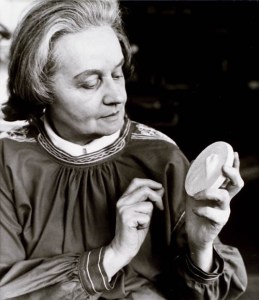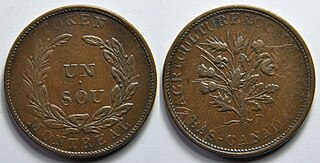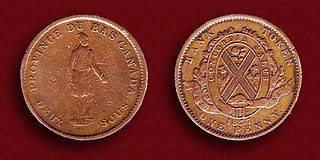Related Research Articles

In Canada, a dime is a coin worth ten cents. It has been the physically smallest Canadian coin since 1922; it is smaller even than the penny, despite its higher face value. According to the Royal Canadian Mint, the official national term of the coin is the 10-cent piece, but in practice, the term dime predominates in English-speaking Canada. It is nearly identical in size to the American dime. Unlike its American counterpart, the Canadian dime is magnetic due to a distinct metal composition. From 1968 to 1999, it was composed entirely of nickel, and since 2000, it has consisted of a steel core with plating composed of layers of nickel and copper.

The Canadian fifty-cent coin is a Canadian coin worth 50 cents. The coin's reverse depicts the coat of arms of Canada. At the opening ceremonies for the Ottawa branch of the Royal Mint, held on January 2, 1908, Governor General Earl Grey struck the Dominion of Canada's first domestically produced coin. It was a silver fifty-cent coin bearing the effigy of King Edward VII.

In Canada, a penny is an out-of-production coin worth one cent, or 1⁄100 of a dollar. According to the Royal Canadian Mint, the official term for the coin is the one-cent piece, but in practice the terms penny and cent predominate. Penny was likely readily adopted because the previous coinage in Canada was the British monetary system, where Canada used British pounds, shillings, and pence as coinage alongside U.S. decimal coins and Spanish milled dollars.
The coins of Canada are produced by the Royal Canadian Mint and denominated in Canadian dollars ($) and the subunit of dollars, cents (¢). An effigy of the reigning monarch always appears on the obverse of all coins. There are standard images which appear on the reverse, but there are also commemorative and numismatic issues with different images on the reverse.
The Charlton Press is a book publishing company that produces pricing guides as well as other books on related topics, including collectables and porcelain figures. The company's first title was Catalogue of Canadian Coins, Tokens & Fractional Currency, published in 1952, and contained all coins used as circulating tender in Canada from 1858 until present.
The Royal Canadian Numismatic Association was founded in 1950. It is a nonprofit association for coin collectors and other people interested in Canadian numismatics. It has members throughout Canada and in other countries. At times, it also works with the Canadian Association for Numismatic Education (CAFNE), an arms length organization, which is defined by the CRA as a Canadian educational and charitable organization. CAFNE provides funding for some of the RCNA's educational seminars and publications.
One of the most profitable aspects of the Royal Canadian Mint (RCM) is its numismatic product line. The first numismatic coin from the RCM was arguably the 1935 dollar commemorating the Silver Jubilee of His Majesty King George V. Though intended for circulation, it was the first Canadian coin commemorating an event. The decision to issue this coin was made in October 1934 by then-Prime Minister R.B. Bennett. There were economic and patriotic motivations for the release of a silver dollar, including a hope to boost the silver mining industry. In future years, the silver dollar would have a more emotional meaning for many Canadians because it was also the first coin to have the Voyageur motif on its reverse.
Since the 1976 Summer Olympics in Montreal, the Royal Canadian Mint has struck Summer and Winter Olympic coins to mark Games held in Canada.
By 1954, a new trend was beginning to emerge for the Royal Canadian Numismatic Association as annual meetings evolved into annual conventions. Working with the Toronto Coin Club as host, the first such convention was held in Toronto in 1954. The conventions offered an agenda of educational forums, bourse activity, competitive exhibits with awards to the winners, and a closing banquet, with the highlight being a special guest speaker.. It was also in 1954 that the association issued its first ever medal to commemorate the event. The tradition of an annual convention and a convention medal continues to this very day.
The Canadian silver dollar was first issued by the Royal Canadian Mint in 1935 to commemorate the Silver Jubilee of King George V. The coin's reverse design was sculpted by Emanuel Hahn and portrays a voyageur and a person of Indigenous descent paddling a birch-bark canoe. The faint lines in the background represent the Northern Lights. The voyageur design was used on the dollar until 1986. It was then replaced with the 1987 Canadian 1-dollar coin. 1967 marked the end of the silver dollar as a business strike, or a coin issued for circulation. After 1967, the dollar coin was made of nickel, except for non-circulating commemorative issues for the collector market, which continue to contain silver.
The Ottawa Mint sovereign is a British one pound coin minted between 1908 and 1919 at the Ottawa Mint (known today as the Ottawa branch of the Royal Canadian Mint. This has augmented debate among Canadian numismatists because some view these pieces as Canadian while others view them as British and thus distinct from the decimal series of Canadian coinage. Since the opening of the Ottawa Mint, the Dominion of Canada’s government wanted to produce decimal gold coins. As it was a branch of the Royal Mint, it was obligated to mint sovereigns on request. When sovereigns were requested, it was usually for export causes.
One of the most highly profitable aspects of the Royal Canadian Mint’s enterprise is in its Numismatic product line. The euphoria surrounding the year 2000 led to the birth of the Millennium 25-cent coin program. The numismatic line included proof quality coins sold individually or as a complete set. This level of excess would come to signify the coming decade. The number of numismatic releases would increase on an annual basis starting in 2003. Numismatic three cents, five cents, and ten cents would be introduced, along with numismatic three dollars and eight dollars. Luxury coins would not be immune to the dramatic increases that ensued. Coins with face values of 250, 300 and 350 dollars would be introduced by 2006.
The Royal Canadian Mint has made coins with various themes. Most recently, ice hockey has been used for many numismatic releases. The first known ice hockey coin was for the 1988 Winter Olympics. Issued on February 25, 1986, the coin featured a goalie on the coin. Edge lettering was also used for the coin, the first time that it was used on silver coins.
Yvon Gariepy was the President of the Royal Canadian Mint from 1975 to 1981. In later years, he worked for Canada Post. Mr. Gariepy was a professional member of the Order of Engineers of Quebec, Professional Corporation of Urbanists of Quebec, Canadian Institute of Planners and the Institute of the Public Administration of Canada.
Starting in 1997, the Royal Canadian Mint started to sell hockey medallions to the public. To commemorate the induction of Mario Lemieux in the Hockey Hall of Fame, a set was issued honouring all three inductees. One set was issued in Sterling Silver while another was issued in Nickel. The success of the release led to future issues.

Dora de Pédery-Hunt, LL.D. was a Hungarian-Canadian sculptor who designed medals and coins. She was the first Canadian citizen to design an effigy for Queen Elizabeth II.

Bouquet sou were a series of tokens that were created for use primarily within Lower Canada in the mid- to late-1830s. Roughly equivalent in value to a half penny, the "bouquet sou" were so called because they displayed a group of heraldic flowers tied together with a ribbon on their obverse. The group of flowers were encircled by one of several legends, which might say "Trade & Agriculture / Lower Canada", "Agriculture & Commerce / Bas Canada" or some variant of these that might also substitute the name of the issuing bank. The other side most typically gave the denomination of "un sou", surrounded by a wreath and the words "Bank Token" and "Montreal". There are a large variety of these tokens, distinguished primarily by the number and variety of flowers that appear in the "bouquet", along with the differences in the legends that appeared on either side of the token. They were initially issued by the banks of Lower Canada, and were later imitated by speculators who produced tokens that looked similar, but were underweight for their denomination. These coins also circulated to Upper Canada, as at least one archeology dig attests. Large numbers of these tokens were produced and many examples can easily be obtained for only a few Canadian dollars, though a few rare varieties can command significantly higher prices.

The Habitant token were a series of tokens that were created for use primarily within Lower Canada and were issued in 1837. Produced as a successor to the popular bouquet sous, these tokens depicted a Habitant on the obverse, a traditional depiction of a French-Canadian farmer in winter clothing, and the coat of arms for the City of Montreal on the reverse. The tokens were issued in both one penny/deux sous and half penny/un sou denominations by the leading commercial banks of Montreal. They were issued in large numbers and can be easily acquired by the modern collector, though some varieties are rare and command a premium.

The Vexator Canadiensis tokens are thought to be politically satirical tokens produced in either Quebec City or Montreal sometime in the 1830s. The tokens present a very crude image of a vaguely male bust on their obverse, and a female figure on the reverse. The legends on either side were deliberately designed so that they are hard to definitively read, but are commonly known as the "vexators" based on a common interpretation of its obverse legend. Depending on the interpretation of the inscriptions, they can either be taken as a form of satirical protest against either an unpopular Upper Canada governor, or William IV as a "tormentor of Canada", or more simply, depicting a fur trapper. Since all of these interpretations are possible, the ambiguity would allow the issuer from escaping being cited for sedition.

The Bust and Harp tokens were tokens originally issued anonymously in the mid-1820s, and circulated primarily in Lower Canada. Due to their anonymous nature, it is not known who placed the order for the original tokens, but they are believed to have been minted in England beginning in 1825. The initial release of the tokens was dated 1825, but a currency regulation issued that same year made the importation of privately issued tokens illegal. As a result, the initial issue was altered and all subsequent issues of these tokens were antedated to 1820 in order to get around this prohibition, which did not prohibit tokens made before this date. They were circulated in large quantities and were widely imitated by minters located in Canada, making for many varieties. Those of particularly poor craftsmanship are considered examples of Blacksmith tokens. They were roughly the size of a contemporaneous half-penny, though generally weighed less. They were widely circulated in Lower Canada for at least 30 years, after which banks began to refuse them as payment except by weight. The more common Bust and Harp tokens can be had for about a few tens of C$, though rarer varieties can command prices in the thousands of dollars.
References
- ↑ The Charlton Standard Catalogue of Canadian Coins, W.K. Cross, p. 127, The Charlton Press, Toronto, Ontario, ISBN 0-88968-297-6
- ↑ "Mountie Money", Christopher Boyer, p. 35, Numismatist, Volume 118, Number 9, September 2005
- ↑ RCMP Vets Net, Last Post. "CEDERBERG, Sven Oscar (Paul) - Regimental #17830 - June 14, 2014 - Ottawa, ON". Ottawa, Ontario: Royal Canadian Mounted Police. Retrieved September 24, 2022.
- ↑ Coins of Canada, J.A. Haxby and R.A. Willey, p.63, The Unitrade Press, Toronto, Ontario, ISBN 1-894763-01-7
- ↑ Coins of Canada, J.A. Haxby and R.A. Willey, p.124, The Unitrade Press, Toronto, Ontario, ISBN 1-894763-01-7
- ↑ Coins of Canada, J.A. Haxby and R.A. Willey, p.131, The Unitrade Press, Toronto, Ontario, ISBN 1-894763-01-7
- ↑ "Mountie Money", Christopher Boyer, p. 35, Numismatist, Volume 118, Number 9, September 2005
- ↑ "Mountie Money", Christopher Boyer, p. 35, Numismatist, Volume 118, Number 9, September 2005
- ↑ The Charlton Standard Catalogue of Canadian Coins, W.K. Cross, p. 387, The Charlton Press, Toronto, Ontario, ISBN 0-88968-297-6
- ↑ "Mountie Money", Christopher Boyer, p. 35, Numismatist, Volume 118, Number 9, September 2005
- ↑ The Charlton Standard Catalogue of Canadian Coins, W.K. Cross, p. 436, The Charlton Press, Toronto, Ontario, ISBN 0-88968-297-6
- ↑ The Charlton Standard Catalogue of Canadian Coins, W.K. Cross, p. 451, The Charlton Press, Toronto, Ontario, ISBN 0-88968-297-6